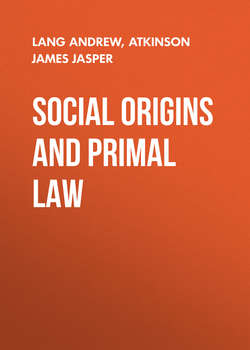Читать книгу Social Origins and Primal Law - Lang Andrew - Страница 8
CHAPTER I
THE EARLY HISTORY OF THE FAMILY
THEORIES OF EXOGAMY. MR. MCLENNAN'S THEORY
ОглавлениеIn any case, Mr. McLennan's hypothetical first groups, like Mr. Atkinson's, were very low indeed. They developed exogamy, not (as in Mr. Atkinson's theory) through sexual jealousy on the part of the sires, but, first, through regular female infanticide. This practice, being reasonable, could not prevail among Mr. Atkinson's anthropoids.43 Girl babies being mostly killed out, women became scarce. Neighbouring groups being hostile, brides could only be procured by hostile capture. Each group thus stole all its brides and became exogamous, and marriage inside the group became a sin, by dint of 'a prejudice strong as a principle of religion.'
This theory of Mr. McLennan's is, I think, quite untenable. The prevalence of female infanticide, at the supposed very early stage of society, is not demonstrated, and did not seem probable to Mr. Darwin. Even if it existed, it could not create a prejudice against marrying the few women left within the group. Mr. McLennan, unhappily, was prevented by bad health, and death, from working out his hypothesis completely. His most recent statement involves the theory that the method of the Nairs of Malabar, living in polyandrous households (many men to each woman) was the earliest form of 'marriage.' But people who, like the Nairs, dwell in large households, are far indeed from being 'primitive.' 'A want of balance between the sexes' led, Mr. McLennan held, to 'a practice of capturing women for wives,' and was followed by 'the rise of the law of exogamy.' The first prohibition would be against capturing women of the kindred (marked by the totem), for such capture, if resisted, might involve the shedding of kindred blood. Women being scarce, through female infanticide, kindred groups would not give up or sell their women to each other (though to the males of the groups, such women could not be wives), nor could women be raided from kindred groups, as we saw. So they would be stolen from alien groups, 'and so marriages with kindred women would tend to go into desuetude.' The introduction of captured alien wives would change the nature of matrimonial relations. Under the Nair system 'a woman would live in the house of her mother, and under the special guardianship and protection of her brothers and her mother's brothers. She would be in a position of almost absolute independence of her husbands…'
But really pristine man and woman can have had no houses, no matriarchal rule of women. The Nairs, not being primitive, have houses, and their women have authority: pristine man was not in their condition. However, captured alien wives would, Mr. McLennan argues, be property, be slaves; and men would find this arrangement (now obsolete) so charming that polyandry and the reign of woman would go out. The only real legal marriage would be wedlock with an alien, a captive, a slave woman. Marriage with a woman of the same stock would be a crime and a sin. It would be incest.44 Really it would be, at worst, concubinage.
This theory seems untenable at every point, community of wives, female infanticide, household life, supremacy of women in the household, living with a non-captive wife reckoning as incest, and, in short, all along the line. Even if the prejudice against marrying native women did exist, it could not be developed into the idea of sin – granting that the idea of sin already existed. To be sinful, endogamy within the group must have offended some superstitious belief, perhaps the belief in the totem, with its tabu.45
43
The practice however, is attributed to tame canary birds.
44
Studies in Ancient History, second series, pp. 57-65.
45
Cf. Custom and Myth (A. L.), p. 258.
